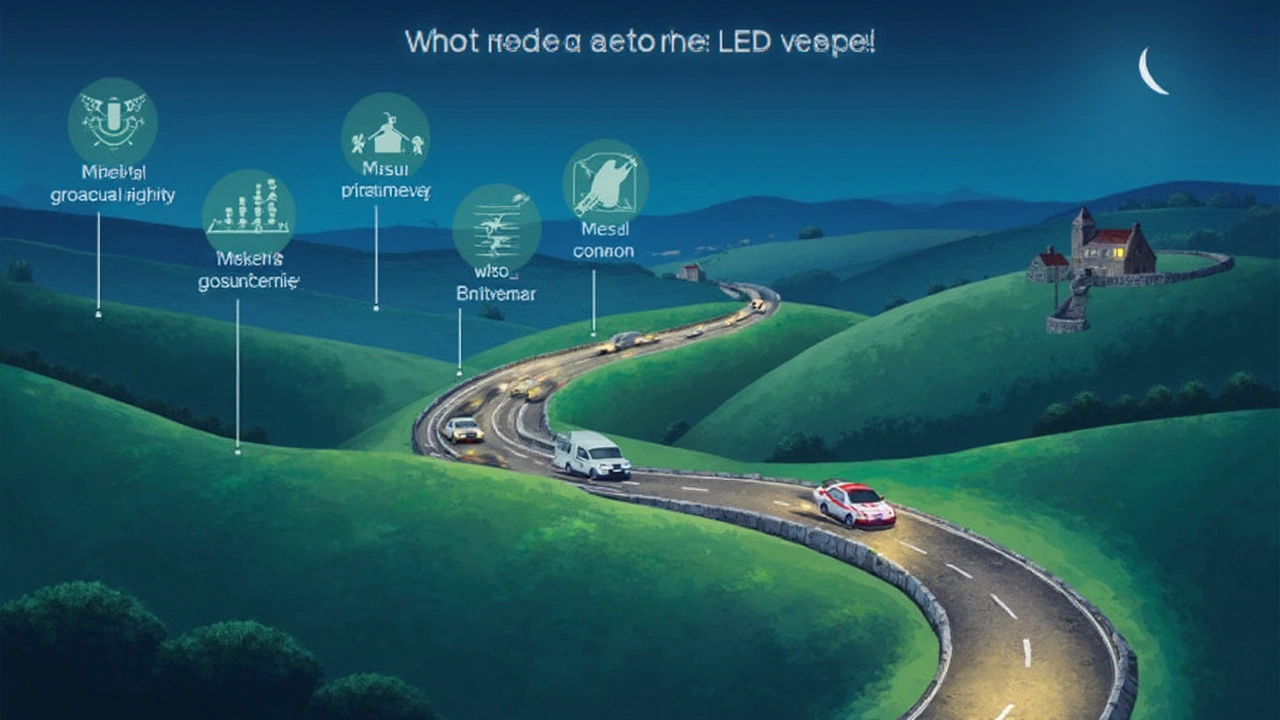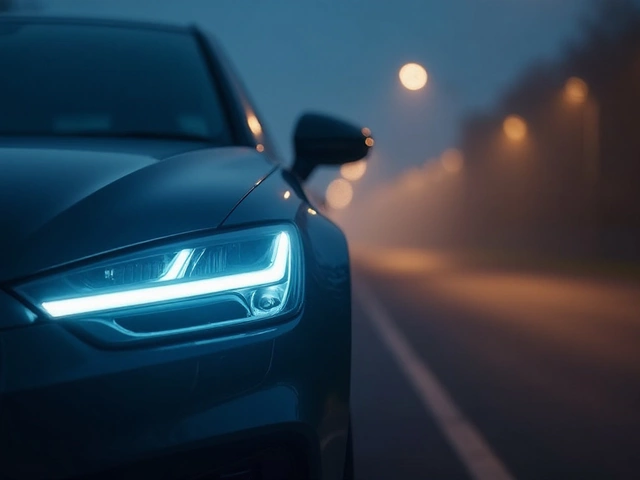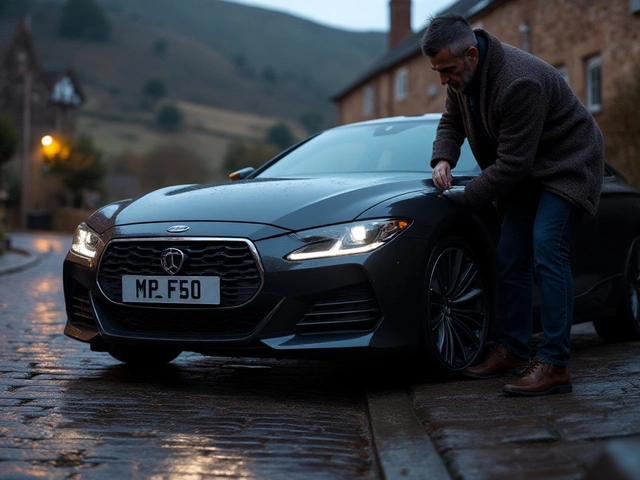Driving at night is way riskier than motoring around during the day—people make up only about a quarter of their trips after dark, but night driving accidents rack up around half the road toll. The reason? Vision takes a dive in the dark. That’s why headlights matter so much. Over the past decade, heaps of drivers have switched from the old halogen bulbs to LEDs. Are they just a flashy trend, or do they actually make driving at night safer?
What Makes LED Headlights Different?
Let’s get straight to it: LED headlights use less energy and last much longer than classic halogen bulbs. But that’s only the start. LEDs (light emitting diodes) blast out light in an instant, reaching peak brightness as soon as you flick the switch. Compare that to halogens that sometimes need a moment to gather steam. LEDs are also more resilient against bumpy roads, which is perfect for anyone who, like me, lives around heaps of potholes or regularly heads out country ways.
One of the biggest pluses? LED headlights don’t waste energy producing heat like halogens do. They channel almost all their current into visible light. That’s why you’ll see LED-equipped cars glowing brighter and whiter on Melbourne’s M1, especially on those cold June nights.
But not all LED headlights are made equal. A top-rated factory-fitted system uses dedicated reflectors and lenses, so the light actually helps you see rather than just throws out glare. Cheap after-market bulbs though? Sometimes you get what you pay for: their beam pattern scatters, leaving bright patches and dark spots—or worse, blinding everyone else on the road. If you’re thinking of upgrading, check your car’s model compatibility and aim for reputable brands that meet Australia’s ADR (Australian Design Rules).
You’ll probably have heard that LEDs can output a "cool white" light that sits closer to daylight. In theory, that means you see colours and road signs more naturally compared to the yellowish beam of halogens. Some studies put this difference in reaction time—our brains supposedly process "daylight" tones faster than yellowish ones. Still, if your headlights chuck pure blue or icy white light, they might make rain or fog worse by bouncing more light back into your eyes. So the sweet spot? Brands that hit 4,000–6,000 Kelvin on the colour temperature scale.
Night-Time Visibility: Brightness Isn’t Everything
Those new LED globes might light up the road like a stadium, but visibility depends on more than just lumen counts. Sure, LEDs often pump out 2,000–4,000 lumens, compared to a standard halogen’s 1,000–1,500. But that number isn’t the full picture. The real game-changer is where the light goes. Quality LEDs have a sharp beam cutoff, putting the brightest bit ahead of you and not into the face of oncoming cars or up trees. That means better visibility on empty roads—and less risk of getting flashed by angry drivers.
Think about the everyday mix of rain, fog, or even those endless November bugs splattering onto your headlights. LEDs stay cooler to the touch, so gunk won't get baked on as quickly—making them easier to clean. Still, the white light from LEDs sometimes makes glare a problem, especially if your windscreen isn’t spotless. Smudgy glass will scatter all that powerful light and distort your view. Keeping your windscreen and headlight covers clean is suddenly twice as important with powerful LEDs.
Brightness can cause trouble for other road users too. Headlights need to be aimed correctly—slight misalignments send blinding glare right at kids on bikes, dog walkers, or anyone sharing the road. Even in high-tech Aussie cars with automatic levelling, adding a roof pod or loading up the boot for a weekend out at Wilsons Prom can still mess up the angle. So if you’ve upgraded to LEDs, a headlight alignment check is more than worth it.
Researchers from Monash University's Accident Research Centre found that when headlights are properly aimed and maintain a safe light pattern, drivers spot obstacles several seconds sooner with LEDs versus halogens. But the catch? If the driver gets dazzled by cheap, misfiring bulbs, reaction times drop off fast. It’s not just your own safety at risk—your lights directly impact everyone else on the road.

Legal Limits and Aussie Road Rules: What You Need to Know
You wouldn’t think headlights would become a legal minefield, but in Australia, aftermarket upgrades can easily make your car unroadworthy. The rules are there to protect everyone: too much brightness, wrong colour, or poor cut-off throws glare at oncoming traffic and gets you a defect notice—or if a cop’s in the mood, a fine on the spot.
Here are some quick facts for Aussies thinking about swapping to LED:
- LED retrofit bulbs replacing halogen globes are legal only if the whole assembly (bulb and housing) is ADR compliant.
- Headlights can’t exceed 2,000 lumens per bulb—way less than what some cheap eBay specials claim to offer.
- Colour temperature for headlights is capped at 4,200 Kelvin under ADR guidelines—bluer than that and you could get pulled over.
- Headlights must project sufficient light (measured in lux at a certain distance) but can’t have a dazzling cutoff or weirdly shaped beams.
- If you’re running a 4x4 or ute with a raised front end, your headlights’ aim matters even more—you’re at eye-level with most sedans and bikes.
You’ll spot a wave of performance headlight kits advertised online as “plug and play,” promising wild brightness. But if you drive into VicRoads, NSW RMS, or any RTA inspection with lights outside the legal limits, you’ll fail roadworthy—even if no one’s noticed yet on the street.
Manufacturers like Mazda, Toyota, and Hyundai now offer high-efficiency LEDs straight from the factory. These are safe bets and usually come paired with auto-levelling and glare reduction. DIY upgrades are riskier. Unless you’re ready to shell out for a full new headlamp unit (not just bulbs), there’s a good chance the outcome won’t match your expectations… or stay legal for long.
| Type | Average Lifespan | Typical Lumen Output | Colour Temp (Kelvin) | Legal in Australia? |
|---|---|---|---|---|
| Halogen | 400–1,000 hours | 1,000–1,500 | 3,200–3,500 | Yes |
| HID/Xenon | 2,000–3,000 hours | 2,500–3,500 | 4,000–6,000 | Yes (ADR compliant units) |
| LED (factory) | 10,000–30,000 hours | 2,000–4,000 | 4,000–6,000 | Yes |
| LED (retrofit) | 5,000–20,000 hours | 2,000–6,000* | 4,000–8,000* | Often no |
*Values vary widely based on brand and whether legally compliant
Real-World Driving: Pros, Cons, and Surprises
Everybody loves a new gadget, but not every upgrade feels like an upgrade once you hit the road. A lot of drivers who swap from halogens to LEDs rave about sharper vision: you can spot lane markings, reflectors, and even that rogue possum making a dash across the tarmac. The light feels crisper. Fatigue doesn’t bite as quickly on long night drives, either, probably because your eyes don’t need to strain as much searching for hazards lurking by the roadside.
On the flip side, there are a few curveballs. On wet roads, powerful LEDs can reflect back in big patches, making it much harder to judge distance on a rainy M80 run or when you’re overtaking a B-double splattering your windscreen with spray. Some drivers—me included—find that if you go too blue or too white, your eyesight takes a hit in heavy fog. That’s where those yellowish lights actually win, cutting the glare and letting you make out the road’s edges.
Then there’s the lifespan hype. Top-tier LEDs last for ages, but bargain ones often die early, especially in heat or heavy vibration. And when they fail, they don’t fade out gently like old bulbs. Sometimes they just go dark—suddenly and completely. Look, nobody wants to lose half their light on a backroad outside Bendigo with no phone reception. Stick with trusted makes even if it means coughing up a bit more.
Maintenance is another thing to think about. Because a lot of LEDs are sealed units, if the light fails, you might need to change the whole assembly, which isn’t just a quick job with a screwdriver anymore. Labor costs come into play, especially on newer models where headlight clusters can be buried behind bumper covers and sensors. Chat with your mechanic before making the leap; sometimes the flashiest tech brings the fussiest repairs.
For those with older cars, not all electrical systems welcome LEDs. You could get flickers, dashboard warnings, or radio static if your car’s wiring isn’t set up for low-draw bulbs. Plugging in extra resistors sometimes helps, but that can add more complexity. If you’re DIYing the swap, check forums and read reviews from people with the exact same car as yours. The jellybean Corolla from 2008 isn’t going to behave like a new Hilux—in lighting, nothing is ever truly one-size-fits-all.

Tips for Maximizing Safety with LED Headlights
Thinking about joining the LED crowd or making the most of the tech you’ve already got? Here’s a bunch of road-tested tips to keep you seeing further (and safer):
- Always clean your windscreen and headlights properly. Dust, mud, and even bug splats turn bright light into blinding glare.
- If you install LEDs, double-check the aim. Pull up facing a wall and see where the beam cutoffs land—they should be level and angled downwards.
- Don’t go for the brightest bulb—pick a model that offers a clear beam pattern, solid build, and proof of ADR compliance.
- If your car develops errors or flickers after swapping, check with an auto electrician. Improper wiring or incompatible bulbs can cause bigger issues down the track.
- Get a professional headlight alignment after upgrades or suspension changes. Extra gear in the boot can shift your beam upwards and dazzle others.
- If you drive a lot in rain or fog, pack a set of old-school halogens or stick to a slightly warmer LED colour temperature—sometimes the best tech isn’t the best for every bend in the road.
- Cold Aussie winters can lead to foggy headlight lenses—LEDs don’t warm up like halogens, so treat your covers with defoggers or clean off condensation regularly.
If you’re the sort who likes numbers and proofs, the RACV reckons that high-efficiency LED headlights can slash down the number of nighttime pedestrian and cyclist accidents, especially when they’re aimed properly. For the technophiles, modern adaptive LED systems (like those on luxury BMWs and Volvos) shadow out parts of their beam in real time to avoid glare for other traffic—cutting nighttime crash rates by up to 15% where fitted. But those setups aren’t cheap, and for most of us, a good basic LED keeps things plenty bright enough.
Bottom line: LEDs for night driving can be a huge win—if you buy quality, stick with legal setups, and keep your car’s glass and lights clear. It’s not just about brightness; it’s about where that brightness lands and how comfortable your eyes feel kilometre after kilometre. Melbourne streets and bush backroads alike can be brutal after sunset, so a smart lighting choice could make all the difference between a close call and getting home without a hitch.




